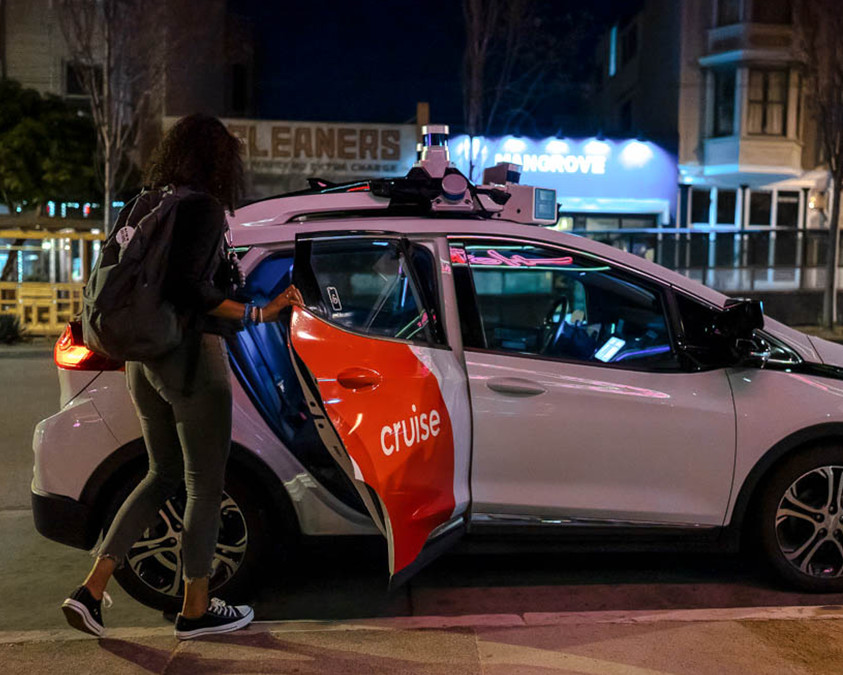Driverless taxi service Cruise got the full go-ahead in San Francisco.
In a win for the autonomous vehicle industry, California regulators have given the green light to Cruise and Waymo to offer commercial robotaxi services across San Francisco 24 hours a day, seven days a week.
The commission voted 3-1 in support of the expansions; Commissioner Genevieve Shiroma cast the sole “no” vote.
The California Public Utilities Commission’s (CPUC) votes in favor of the AV companies come in spite of mounting opposition from residents and city agencies that have urged caution and a more incremental approach to expansion. Since AVs hit the streets of San Francisco, there have been numerous instances of vehicles malfunctioning and stopping in the middle of the street — referred to as “bricking” — blocking the flow of traffic, public transit and emergency responders.
Cruise and Waymo both offer limited paid services in San Francisco — Cruise charges for driverless rides at night, and Waymo charges for its robotaxi service throughout the city at any time of day, but with a human safety operator present. The permit extension allows the companies to expand their services significantly and with no limit on the number of robotaxis they can put on the roads.
While Cruise and Waymo have both said they would expand incrementally, and not all at once, scale is vital for the companies’ success. Developing, testing and deploying AV tech has cost Cruise and Waymo millions of dollars. Waymo has had to pull back on operations this year after Alphabet issued a slew of layoffs in the first quarter. In July, the company shut down its self-driving trucks program to shift all its available resources to ride-hailing. If either Waymo of Cruise are to get a return on their investments, they need to grow exponentially in San Francisco and beyond.
The CPUC ended up voting to grant the permit expansions because it did not anticipate the robotaxi services to result in significant safety risks. The agency’s primary role is to promote the public interest by ensuring safe, reliable and affordable utility services. As long as Cruise and Waymo’s services meet those requirements, the CPUC doesn’t have the authority to limit them.
Hold that thought on expansion for a minute. This isn’t quite the end of the line for Cruise and Waymo, as San Francisco’s City Attorney has filed motions with the CPUC to pause the firms’ plans to charge for robotaxi rides in the city at all hours, which is to say to limit their hours of operation for now. A day later, the robotaxi companies were ordered to scale back their fleets by half following a crash with a fire truck. I don’t know how long that will last, I’m sure this will be moving ever forward, but there are still some bumps in the road.
For a more comprehensive look at what’s happening, Vox interviewed a local reporter who’s been on this beat and is a regular rider of these vehicles as part of it. She had some observations about other issues:
Well, have there been any problems yet with these robocars?
That’s an understatement, honestly. It’s pretty crazy. These cars will just get caught. Let’s say there are 10 fire trucks coming down to stop a blaze in San Francisco. The Cruise cars don’t know what to do. They’ll just brick up on the street and not move. The issue with that is that they’ll be blocking traffic. They’ll be blocking the emergency vehicles.
So they crumble under pressure.
They definitely crumble under pressure. And they were put to the test this Friday. San Francisco has this pretty famous music festival called Outside Lands. Tens of thousands of people attend. It’s a really big event for the city. And Cruise and Waymo were still operating around the park where the festival was held.
This was day one of the new world that we were living in in San Francisco.
Day one of the new world. And they had a meltdown. As many as a dozen stalled Cruise cars blocked the streets in a neighborhood in the north part of the city. The company said that it was because all of the people at Outside Lands disrupted the cellphone signal or the signal that the Cruise cars use to operate.
The robots blamed the people.
Yeah, the robots blamed the people. A lot of people said that the robotaxis just couldn’t handle the floods of people walking on the street. They’ll just stop. And it’s kind of funny to see because the cars kind of look clueless. And there’s no driver in them either. So you really can’t yell at them to move or honk at them either. I think something that people don’t talk enough about too, with Cruise, is that they’re such cute little cars, that it really, truly is comical when they mess up.
This reporter is the same one who wrote about people having sex in Cruise robotaxis, because why not? There’s no one else in the vehicle to stop them. I will note that way back in 2018 I blogged about the issue of who is responsible for cleaning self-driving vehicles. It’s still not clear that there’s an answer to that question. Ride with caution, and maybe some Lysol, if you must.
Why do I keep writing about this stuff? Well, it fascinates me, and it’s coming our way. Cruise is operating in Austin, and Waymo is right behind it. Dallas is also in their sights. I have other questions about what all this means – like, for example, where are all the robotaxis kept at night when they’re not in use? – and I’m sure I’ll have more.

